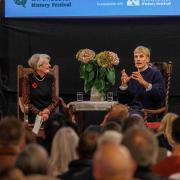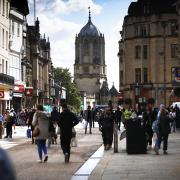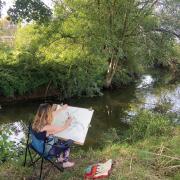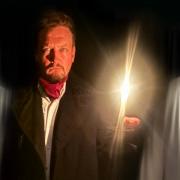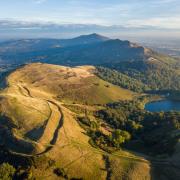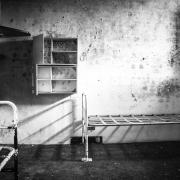When we think about stories in the landscape, we may immediately think of supernatural stories – like those of ghosts, dragons, giants, and fairies – or of legendary history, like the last pig in Gloucester during the Civil War siege. Sometimes we see public art that illustrates these tales – like the statue of Bladud and his pig in Bath. But mostly we rely on books or articles to discover our local stories. We may forget about the one place that, in most towns and villages, is still, to this day, full of stories – the church.
I’ve just been to the Sacred Music Festival in my home town, Stroud. Most of the events take place in the church, and so, while listening to the music or singing along, you can look at the carvings and windows all around you. How many people today know the stories these tell? Back in the Middle Ages, when most of our Cotswold churches were built, many of the people who attended church couldn’t read; and they couldn’t understand the words of the ceremonies, because they were in Latin. Only a privileged few could understand Latin, the language of both church and law. But the medieval church had a way of telling the stories of the Bible – through wall paintings, stained glass, wood carvings, stone sculpture and more.
Today, it is rare and exciting to discover any of those things from the Middle Ages, since during the Reformation in the 16th century, and again after the Civil War in the 17th, much of this decoration was removed and destroyed. We’re lucky in the Cotswolds to have some superb survivals, such as the complete scheme of glass from the early 16th century in Fairford, and the wall paintings from the 14th and 15th and, most remarkably, the 12th century in Kempley. In these rare cases we can follow the tales they tell from start to finish. This article takes us to two special churches in the heart of the Cotswolds, St Nicholas’s, Oddington and St Leonard’s, Bledington, with a lovely walk between them.
St Nicholas’s sits on the edge of Lower Oddington, near to the old manor house, Oddington House. In the mid 19th century a more convenient chapel was built halfway between the Upper and Lower villages. St Nicholas’s was left moulder until 1913, when it was restored under the auspices of the Society for the Protection of Ancient Buildings. Under the whitewash on the north wall was discovered a huge wall painting – a Doom, or Last Judgement, dating back to about 1340. It’s faded now, but with a bit of effort you can see what’s going on.
In the top at the middle sits Jesus with his apostolic henchmen, presiding over the fate of all souls on Judgement Day. To the left, naked souls troop into a castle. They’re the lucky ones – this castle is heaven. At the bottom, souls are rising bodily from their graves to be judged. Others mill about, one wearing a crown and another a mitre. Even kings and bishops must be judged! And some are found wanting. On the right a bestial hellmouth receives terrified souls into the flames that a stripey demon is fanning the flames with a pair of bellows. Another demon takes a hanged man. Yet more are being boiled alive in a cauldron! This terrifying sight would have been the first thing parishioners saw as they came into church.


When you come out of the church, clock the 12th century dragon heads on the south door, protecting the church from evil spirits, and walk around to see the rare outdoor effigy tomb of Alice Parsons, who died in 1695. Her gown and headdress are still visible, but her face has worn away in the weather of 300 years.

We can see St Christopher carrying the Christ Child, and the Virgin, resplendent in her crown and ermine gown. St Christopher was from the Levant and was very tall – seven foot five, says the story! He wanted to serve the greatest king, and, as his king feared the Devil, Christopher went after the Devil to serve him. He met the Devil in the guise of the leader of a band of robbers and followed him until he saw him avoid a wayside cross. The Devil, it seemed, feared Christ! Christopher encountered a hermit, who said that, because of his height, he should help people cross a dangerous river. That is how he met Christ. The little child he carried was as heavy as the world, and the child said to him, ‘You had on your shoulders not just the world, but him who made it!’ Christopher’s name means ‘Christ-bearer’.

In the chancel you’ll find the Virgin being crowned after ascending to heaven. The glass here is part of a of what was once a chantry chapel that Nicholas and Agnes Hobbes, residents of the late 15th century, paid lavishly to have constructed and have masses sung in it to speed their souls through purgatory. Rather than Seven Deadly Sins, the Hobbes had Seven Sacraments in their window. The words ‘wedlock’ and ‘priesthood’ survive, but the names of the other sacraments are lost.
There are stories even in the images of the Apostles above the Coronation. St John the Evangelist carries a cup with a tiny dragon in it. Why? Because he once was given a cup of poison and drank it with no harm. How to depict poison? Medieval artists love their dragons, and dragons were said to poison water.

Back outside, turn right and head up the lane to the main road, then follow the footpath around a small hill back to the Diamond Way and retrace your steps to Oddington. By now, it may be nearing dusk, and the trees and tombstones casting looming shadows. Was that a figure you just saw? For a short time, Oddington did have its ghost. In the 1940s the restored church was suffering from a leaking roof. The old sexton, worried about the holy book getting damp in the church, took it home for safekeeping, but before the next service he was dead and buried in the churchyard. His son put the Bible away and forgot about it – until he started seeing the wispy figure of an old man drifting by the church. He immediately recognised his father, remembered the Bible, brought it straight back, and the ghost faded away. The thing is, when I visited the other week, I found no Bible in the church, so perhaps the old man is restless once more?
COMPASS POINTS
Distance: 5 miles.
Duration: 2 hours, plus church-visiting time.
Level: Easy, but can be muddy
Parking: Beside St Nicholas’s, Lower Oddington
Toilets and refreshments: The Fox, Lower Oddington; The King’s Head, Bledington
Transport: If you need to come by public transport, it’s best to start the walk at Bledington so you can use the nearby railway station at Kingham. Hourly trains between London and Great Malvern go through Oxford. This adds an extra mile of walking each way.
LINKS
Route: https://gb.mapometer.com/walking/route_5537939.html
St Nicholas’s, Oddington: https://www.evenlodevalechurches.org/oddington-st-nicholas
St Leonard’s, Bledington: https://www.evenlodevalechurches.org/bledington












